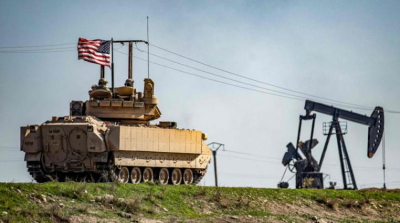NOVANEWS

The Iraq war cost $3 Trillion. 4,800 US soldiers were killed and 32,000 seriously wounded. Iraqi civilian casualties range around 600,000.
Was It Worth It?
“This war will be long seen as boon for the few, and a bane for the many.”
by RA
(our Baghdad Correspondent)
In the build-up to the Iraq war, the United States used Iraq’s alleged “weapons of mass destruction” to justify the decision to invade the country.
What were the real reasons for the war? What were the costs and benefits from the US point of view?
REAL REASONS OF THE WAR
1. Control of Iraq’s oil: Second only to Saudi Arabia, Iraq possesses more than 60% of the world’s known oil reserves, amounting to 115 billion barrels. Thanks to the war, American oil companies returned to Iraq, 36 years after Saddam nationalized them. Remarkably, when the war started, oil was just at $26.00 a barrel. After the invasion, prices kept rising to new heights and reached a record of $145.75 in 2008.
2. Preservation of the U.S. dollar as the world’s reserve currency: In late 2000, Iraq converted to the Euro in exchange for oil. Had an increasing number of countries followed suit and shifted away from the dollar, the U.S. would have been dealt a huge blow inflicted by a plummeting dollar.
3. Elimination of a threat to Israel: The centrality of Israel in any U.S. Mideast strategy is a foregone conclusion. Iraq possessed Scud long-range ballistic missiles which directly threatened Israel. In 1991, Iraq attacked two Israeli cities with Scud missiles. It was the first time Tel Aviv had been hit in the history of the Israel-Arab conflict. Saddam also doled out thousands of dollars to families of Palestinians killed in fighting with Israel. Toppling him stemmed a source of support to Palestinians and eliminated the direct missile threat.
4. Weapons field-testing: In real-battle mode, the Pentagon could use a long list of high-tech and newly developed weapons, such as the highly destructive nano-wave weapons, e-bombs, sensor fuzed weapons, laser weapons and agent defeat bombs.
5. War profiteering: The U.S. targeted the privatization of the Iraqi infrastructure by granting lucrative (no-bid) contracts to the likes of Halliburton, Blackwater, Chevron, Shell, Lockheed, DynCorp, and KBR, all of whom were unwavering supporters of the Bush administration.
COSTS OF THE WAR
In 2011, the Congressional Research Service estimated that the U.S. will have spent almost $802bn on funding the war by the end of fiscal year 2011. The actual cost, however, may exceed 3 trillion dollars when replacement and maintenance costs for equipment and the care for wounded troops are factored in.
On the other hand, 4,487 U.S. troops were killed in addition to 32,223 wounded (one-fifth of whom have suffered serious brain or spinal injuries and one-third have developed serious mental health problems – chief among them, post-traumatic stress disorder – soon after end of deployment).
The war did also exact a toll on Iraqi civilians and government forces. UN reports state that Iraqi civilian casualties, commonly reported to have ranged between 50,000 and 100,000, have been significantly under-reported. Some informed estimates put Iraqi civilian casualties at over 600,000 (including 55,000 Iraqi insurgents), whereas about 5 million Iraqis were permanently or temporarily displaced. Besides, more than 10,000 policemen and soldiers were reported killed as of July 31, 2011.
UNINTENDED CONSEQUENCES: A STRONGER IRAN
During his rule, Saddam marginalized the Shi’a and stood as a bulwark rival against Tehran on behalf of neighbors like (Sunni) Saudi Arabia, which funded Iraq’s eight-year war against Iran.
The power vacuum in Iraq has been largely filled by Tehran. The invasion had shuffled the cards of the Iraqi domestic power equation: Shi’a have risen to power in Baghdad, Kurds have achieved autonomy, and Sunnis have been pushed to the sidelines. This has played into Iran’s hands, enabling it to increase its political and religious influence in a friendlier Iraq.
The post-war Iraq has eased the pressure on Iran. It has created breathing room for Tehran to pay more attention to the U.S. army presence in Afghanistan and to Saudi Arabia, the longtime U.S. ally.
The fall of a longtime foe and the U.S. withdrawal from Iraq have significantly strengthened Iran – hardly something the United States originally intended.
AMERICAN COMPANIES PROFIT
Several American or U.S.-based oil services companies such as ExxonMobil, Halliburton, Schlumberger, Baker Hughes, and Weatherford International have won huge drilling and well refurbishment contracts and subcontracts.
Some analysts estimate that nearly half of the expected $150 billion that international oil giants are expected to spend at Iraqi oil fields over the next few years will be awarded to American drilling subcontractors.
While other international companies have established a footprint for building facilities and processing pipelines, U.S. oil services companies are set to take over most of the drilling contracts in the six major Iraqi oil fields.
WAS THE WAR WORTH IT?
Looking at it from an American prism, the Iraq war turned out to be a bloody, prolonged and high-cost commitment in terms of lives and treasure.
The U.S. credibility has been tarnished by the groundless pre-war claims set forth by the Bush Administration. The removal of Saddam Hussein was eclipsed by the rise of a more belligerent Iran.
The U.S. dollar has maintained its supremacy but the trillions spent in Iraq will burden the U.S. economy for years to come. Israel was relieved from a historical threat only to be replaced by that of the Mullahs in Tehran. The war gained the U.S. unlimited access to Iraqi oil. But while American companies have emerged biggest winners, the U.S. taxpayers have borne the brunt of its gigantic cost.
This war will be long seen as boon for the few, and a bane for the many.
Related – Iran & Iraq sign Defence Cooperation Agreement
Iraq to become World’s 2nd Largest Ol Producer by 2030’s
also by RA –Iraq Stymied in Face of Challenges
First Comment from Day
The Iraq occupation was part of the larger strategic goals of the New American Century plan to control 7 Middle East state in 5 years. Saddam’s army was easily beaten but Rumsfeld underestimated the magnitude of the blowback or ‘insurgency’ that ensued as soon as the “Shock and Awe” wore off.
The ferocity of the Battle of Feluja coupled with the unpredictable reactions of Gaddafi and Assad cost the Bush/Blair Blitzkrieg to lose the momentum far short of their goal. A lot of people missed this. The plan called for Gaddafi and Assad taking hostile actions. Instead, they offered to cut deals with the US State Department.
Israel’s summer of 2006 attempt to start a war with Lebanon backfired. The plan was to make it seem Israel was in dire danger from a Hezbola onslaught, thus gaining world sympathy to draw in NATO forces to occupy the Israel’s flank in North Africa. Instead, Sharon’s attack on Lebanon was such vicious overkill that NATO balked and nothing came of it. The US State Department had to go back to the drawing board and proceed setting up “Plan B” – CIA backed “spontaneous democratic revolutions”, brand name: Arab Spring ™.
The State Department says they like democratic governments, but what they really want is the appearance of Anti-American, Anti-Israel Muslim regimes out of chaos. While media pretends that Iraq, Libya, Egypt and soon Syria are more dangerous, in reality their military strength has been rendered incapable of fighting an international war.
Through it’s policy of de-stabilization through support of subversive mercenary ‘revolutions’, the State Department is setting up them up to be paper tigers that a US/NATO war can strike down in the event of war with Iran. Iraq, Libya, Egypt and Syria currently pose a much weaker military threat to Israel’s flank in the event of Iran war than they did in 2010.
If the Iraqi government seems for the moment to have turned out unfavorably for US State Department policy, consider the peculiar value of copycats of Iran to US rhetoric. How can anybody say that Iraq is ‘stronger’? They have no army. They lost two generations of Iraqi manhood. The US State Department killed 600,000 civilians during the last ten years, and I can’t find a figure for how many children were crippled and maimed. During the 1990’s the Bush/Clinton Administrations killed 500,000 children through the same kind of sanctions they’ve imposed on Iran and Syria. Here’s Madeleine Albright in 1996. saying 500,000 dead Iraqi Children was “worth it”.
http://www.youtube.com/watch?
Before the “Gulf War” in 1991, Donald Rumsfeld was selling Saddam Hussein weapons under the table for the “Iraq/Iran War” that killed a million Iraqi and Iranian young males between 1981-1988. So the notion of that Iraqis and Iranian are allies is a media con that only Westerners would believe. Iraqis are Arabs, Iranians are Persians. They’ve often been at war with each other.
I’m sure everybody’s seen this photo. Rumsfeld gives Masonic handshake with Saddam and State Department diplomat. http://www.youtube.com/watch?
So in fact US policy killed over 1.6 million Iraqis since 1981.
If the Iraqi government seems for the moment to have turned out unfavorably for US State Department policy, it’s a setup for pretext for WW III to get Iran too.



